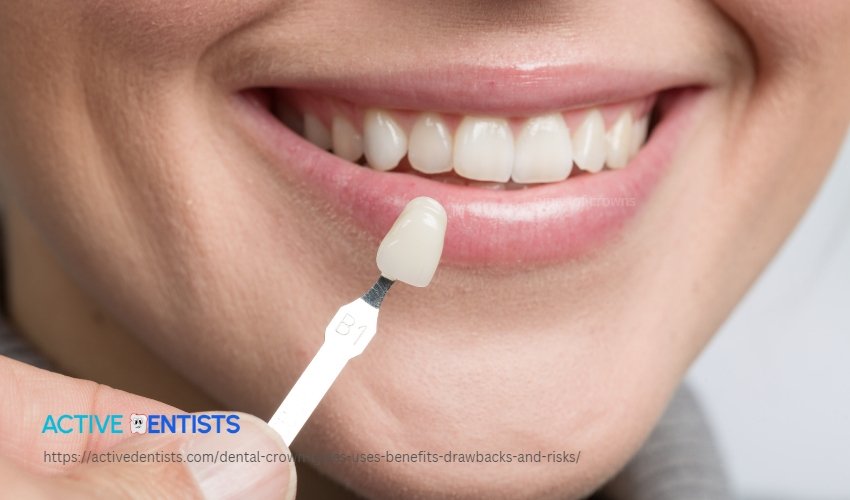Once upon a toothache, in the fascinating world of dentistry, there existed a solution known as a dental crown. Much like a royal crown sitting atop a king or queen’s head, dental crowns are ‘caps’ placed over a tooth, working their magic to restore, strengthen, and enhance the tooth’s appearance. Today, we’re going to unravel the mystery behind these restorative wonders – their uses, types, benefits, drawbacks, and risks. Buckle up for an enlightening journey!

Dental Crowns and Their Uses
Dental crowns are incredibly durable and often last at least 10-15 years (and often much longer) with proper care and oral hygiene. They offer a long-term solution to many dental issues and can help to improve the overall health and appearance of your smile. Dental crowns are the go-to solution for a variety of dental conditions. They come to the rescue when a tooth has suffered significant decay, injury, or when a root canal has been performed. Crowns are also employed for cosmetic reasons, to improve the appearance of discolored or misshaped teeth. If a tooth is missing altogether, dental crowns paired with dental implants or bridges play a crucial role in filling that gap and bringing back your winning smile.
A dental crown may be needed in the following situations:
- To protect a weak tooth (for instance, from decay) from breaking or to hold together parts of a cracked tooth.
- To restore an already broken tooth or a tooth that has been severely worn down.
- To cover and support a tooth with a large filling when there isn’t much of the tooth left.
- To hold a dental bridge in place.
- To cover misshapen or severely discolored teeth.
- To cover a dental implant.
- To make a cosmetic modification.
Types of Dental Crowns
| Types of Crowns | Description |
|---|---|
| Metal Crowns | These are the sturdy warriors made from gold, palladium, nickel, or chromium. They’re strong, long-lasting, and rarely break or chip. However, their metallic color makes them more noticeable, so they’re often used for out-of-sight molars. |
| Porcelain-Fused-to-Metal Crowns | These crowns are the diplomats, offering a balance between durability and aesthetics. They’re strong thanks to their metal structure and can be color-matched to your natural teeth, but they do have a chance of chipping or breaking off. |
| All-Porcelain Crowns | The beauty queens of the bunch, these crowns provide the best natural color match and are an excellent choice for people with metal allergies. However, they aren’t as strong as metal crowns and might wear down opposing teeth a bit more. |
| All-Resin Crowns | These are the economical members of the royal court. They’re less expensive than other crown types but wear down over time and are more prone to fractures. |

Benefits of Dental Crowns
Dental crowns come with several benefits, including enhanced aesthetic appeal, protection for your teeth, and improved functionality when eating or speaking. They also offer long-term durability, often lasting anywhere from 10 to 15 years with good oral hygiene.
However, there are a few potential drawbacks. Getting a crown usually requires at least two visits to the dentist, and the tooth will need to be filed down to make room for the crown. Temporary crowns, placed while you wait for the permanent one, can also sometimes come loose.
The Road Less Traveled: Risks Associated with Dental Crowns
While dental crowns are generally safe and effective, there are a few risks to consider. These can include sensitivity or discomfort, particularly in the period right after the procedure. There’s also a small risk of infection or nerve damage, which could require further treatment like root canal therapy.
In very rare cases, an allergic reaction to the materials used in the crown might occur. It’s also possible for the crown to become chipped, loose, or even fall out, requiring a visit to the dentist for repair or replacement.

Disadvantages of dental crowns
Dental crowns, while an effective restorative dentistry solution, come with potential drawbacks. A crown may not fit perfectly, leading to discomfort or sensitivity. Increased sensitivity, especially to temperature extremes, may also occur post-procedure due to enamel filing. The crown placement process, which typically requires multiple dental visits, can be time-consuming. There’s a risk of damage to surrounding teeth during the fitting process and potential decay under the crown if oral hygiene is not maintained. Dental crowns can be expensive, and they may not always meet aesthetic expectations, particularly when using certain materials or over time. Despite these potential disadvantages, dental crowns are a common procedure with a high success rate. Discussing these points with your dentist and understanding your unique dental needs are essential in making informed decisions about your oral health.






